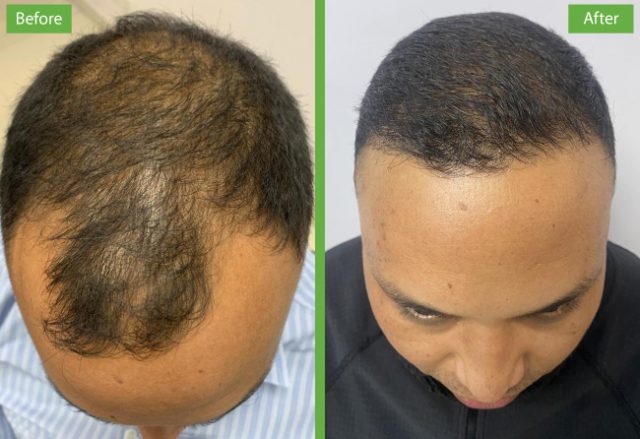Hair Restoration

What is Hair Restoration?
Hair restoration is a process that has been around for many years, but advancements in technology, techniques, and medical research have made restoring thinning or receding hair more natural looking and effective than ever before. Hair loss affects millions of people, with men being more susceptible than women. Fortunately, with hair restoration, anyone can regain a full head of hair, making them feel younger, more vitalized, and more confident.
Causes of Hair Loss
Before getting into the details of hair restoration, it’s important to understand what causes hair loss. For men, male-pattern baldness is the most common condition that leads to hair loss. This is due to genetics and the hormone dihydrotestosterone (DHT).
When DHT attaches to hair follicles, it can cause them to shrink or stop growing altogether, leading to thinning hair. For women, hair loss can also be caused by genetics, as well as hormonal imbalances, menopause, pregnancy, and certain medical conditions. Additionally, certain medications and treatments, such as chemotherapy, radiation therapy, and autoimmune disorders, can lead to hair loss.
Types of Hair Restoration
Types of Hair Restoration
There are several types of hair restoration procedures available today. The three most popular and effective methods are Hair Transplant and Platelet-rich plasma (PRP) therapy.
1. Hair Transplant:
A hair transplant is a surgical procedure in which hair follicles are taken from a donor area, typically the back of the head, and transplanted into the balding or thinning area. There are three types of hair transplant procedures: Follicular Unit Transplant (FUT), Follicular Unit Extraction (FUE) and DHT with No Root Touch Technique. FUT involves removing a strip of scalp from the donor area and then dissecting it into individual hair follicles for transplantation. FUE, on the other hand, involves individually removing hair follicles from the donor area with a small micro-punch and then transplanting them to the recipient area.
Both FUT and FUE hair transplants have their advantages and disadvantages. FUT is less expensive but leaves a linear scar on the scalp. FUE, on the other hand, is more expensive but leaves minimal scarring and has a higher success rate. However the Best option is DHT with No Root Touch Technique that ensures more hair growth.
2. Platelet-Rich Plasma (PRP) Therapy:
PRP therapy is a non-surgical option that involves using a patient’s own blood to stimulate hair growth. A small amount of blood is drawn from the patient and put into a centrifuge to separate the platelet-rich plasma from the rest of the blood. The PRP is then injected into the scalp, promoting hair growth and thickness.
PRP therapy is a safe and effective option for those with thinning hair, but it may not be as effective for those with significant hair loss. Multiple treatments are often required, and results may take several months to become noticeable.
What to expect after treatment?
Hair restoration is a life-changing process that can help restore confidence and self-esteem for those experiencing hair loss. With advancements in technology and techniques, restoring thinning or receding hair is more effective and natural-looking than ever before. Whether it’s through a hair transplant, PRP therapy, or scalp micropigmentation, there are options available to fit every patient’s unique needs and preferences. Consultation with a qualified specialist will help determine which method of hair restoration is right for you.
Benefits of Hair Restoration
Medication
Treatment options exist for pattern (hereditary) baldness. The most typical choices include:
Rogaine (minoxidil):
Minoxidil is available over-the-counter (non-prescription) in liquid, foam, and shampoo forms. Apply the product to the scalp skin once daily for women and twice daily for men for the best results. Many people favour foam that is applied to wet hair.
Propecia (finasteride):
This medication is prescribed specially for men. It is a daily medication to be taken. The hair loss of many men using finasteride slows down, and some even report fresh hair growth. Before it can be determined if it’s working well or not, it can take a few months. To keep any benefits, it must be taken continuously. For males over 60, finasteride might not operate well as to the younger ones.
Other medications:
Spironolactone (Carospir, Aldactone) and oral dutasteride (Avodart) are further oral treatment alternatives
- How long does Hair Restoration last?
90 to 100 days later, or roughly three months after, fresh hair begins to grow and keeps growing normally. The transplanted hairs start to seem natural about six months following the hair transplant procedure and will keep growing for the rest of your life.
- Do I have a chance of succeeding in Hair Transplant surgery?
Healthy hair is present on the sides and back of the head in the perfect candidate for hair restoration surgery. These locations serve as the graft donors. The majority of men and women who are suitable candidates for hair restoration surgery have well-defined baldness, thinning hair, and limited hair loss as a result of scalp traumas or frequent cosmetic operations.


